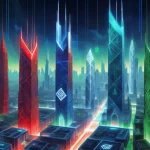Polygon Surges Past Bitcoin and Solana in NFT Sales, Driven by Courtyard Collection

Polygon Surges in NFT Sales Volume, Outpacing Bitcoin and Solana
Polygon has recently surged past Bitcoin and Solana in daily NFT sales, reaching a significant volume of $2.8 million, up 140% from the previous day. This impressive growth is largely driven by the Courtyard NFT collection, which alone accounted for over 80% of Polygon’s NFT trading volume. Ethereum, despite a 15% decrease in sales to $3.3 million, continues to lead the NFT market, followed by Bitcoin at $2.6 million and Mythos Chain at $2 million.
- Polygon’s NFT sales soar to $2.8 million, a 140% increase.
- Courtyard NFT collection dominates with over 80% of sales.
- Ethereum remains top despite a 15% sales drop.
Polygon, a layer-2 scaling solution for Ethereum, has made a remarkable ascent in the NFT market, positioning itself as a strong contender in the blockchain space. Non-fungible tokens (NFTs) are unique digital assets that represent ownership or proof of authenticity of a specific item or piece of content, and Polygon’s platform has become a hotbed for these digital collectibles. The recent surge in Polygon’s sales underscores the platform’s ability to offer scalability and lower transaction costs, which are crucial for NFT creators and collectors alike.
The Courtyard NFT collection has been a major catalyst for Polygon’s growth. Launched in 2023, Courtyard features 90,435 trading cards that blend digital NFTs with physical collectibles, appealing to a niche market of trading card enthusiasts, especially Pokémon fans. The collection saw a staggering 267% increase in sales from the previous day, contributing $3 million to Polygon’s total NFT trading volume. This success story highlights how targeting specific communities can drive significant growth in the crypto world.
Polygon’s ecosystem is not solely reliant on Courtyard, however. Other collections such as OKX NFT, Infinitex, LED collection, and Blockchain City NFT are also contributing to the platform’s growth, showcasing Polygon’s versatility in catering to various interests and communities.
While Ethereum’s recent 15% decrease in NFT sales might raise concerns, it’s essential to remember the inherent volatility of the NFT market. Ethereum’s established ecosystem and widespread adoption continue to provide a solid foundation, but the competition is intensifying. Polygon’s scalability and cost advantages are proving to be a powerful draw for both creators and collectors, challenging Ethereum’s dominance.
From a Bitcoin maximalist perspective, the rise of NFTs on other blockchains might be viewed with skepticism. Bitcoin maximalists often argue that Bitcoin’s primary function as a store of value and a decentralized currency should remain its focus, questioning the long-term viability and relevance of NFTs on other chains. However, innovations like Bitcoin Ordinals, which allow for the creation of NFTs directly on the Bitcoin blockchain, show that even Bitcoin is evolving to include NFT functionality, albeit in a more limited capacity compared to dedicated NFT platforms.
Despite the optimism surrounding Polygon’s growth, it’s important to acknowledge potential challenges. Scalability issues could still arise as demand for NFTs increases, and security concerns are ever-present in the fast-paced world of blockchain technology. As always, a balanced approach is necessary—while the potential of NFTs and blockchain technology is undeniable, the crypto space remains rife with uncertainties and risks.
Looking ahead, the NFT market’s evolution presents exciting opportunities for different blockchains to carve out their niches. Polygon’s success in attracting niche collections like Courtyard demonstrates the power of innovation and community engagement. However, it’s worth questioning whether the current NFT frenzy is a bubble waiting to burst. NFTs may be the new Pokémon cards, but unlike the cards of our childhood, you can’t blame your mom for throwing them away.
Let’s address some key questions and takeaways:
- What has led to Polygon’s increase in NFT sales volume?
Polygon’s increase in NFT sales volume is driven by its scalability, lower transaction costs, and the popularity of niche collections like Courtyard, which appeal to specific communities.
- How does Polygon’s NFT sales volume compare to other major blockchains?
Polygon’s daily NFT sales volume of $2.8 million places it second behind Ethereum ($3.3 million) and ahead of Bitcoin ($2.6 million) and Mythos Chain ($2 million).
- What specific features of the Courtyard NFT collection contribute to its success?
Courtyard’s success is attributed to its combination of digital NFTs with physical trading cards, targeting niche communities like Pokémon enthusiasts, and its significant sales volume.
- Which other NFT collections are contributing to Polygon’s growth?
Other collections contributing to Polygon’s growth include OKX NFT, Infinitex, LED collection, and Blockchain City NFT.
- How has Ethereum’s NFT market performed recently?
Ethereum remains the top-traded blockchain for NFTs with a weekly sales volume of $33.15 million, though it experienced a daily decrease of 15% from the previous day.
As we navigate this dynamic and unpredictable space, staying informed and maintaining a balanced perspective is crucial. Polygon’s success story is a testament to what’s possible with the right mix of innovation and community engagement. Keep your eyes peeled for the next twist in this unfolding saga of digital assets and decentralized finance.



